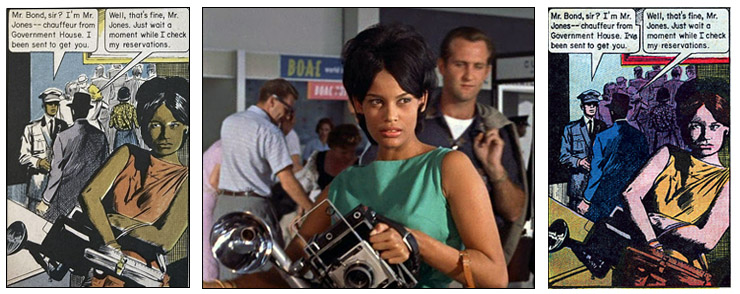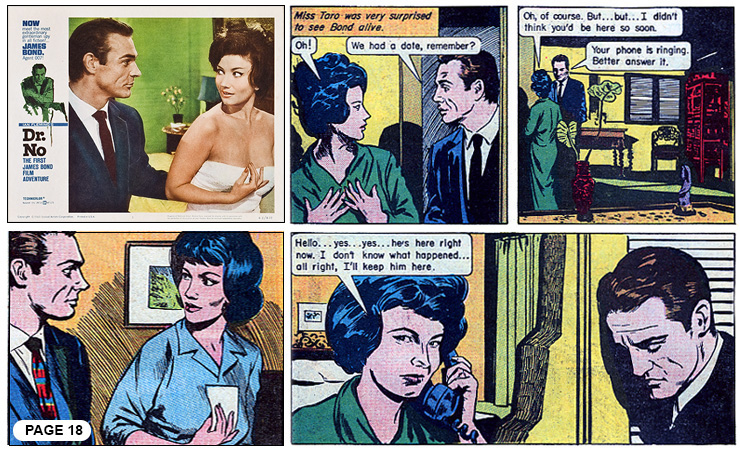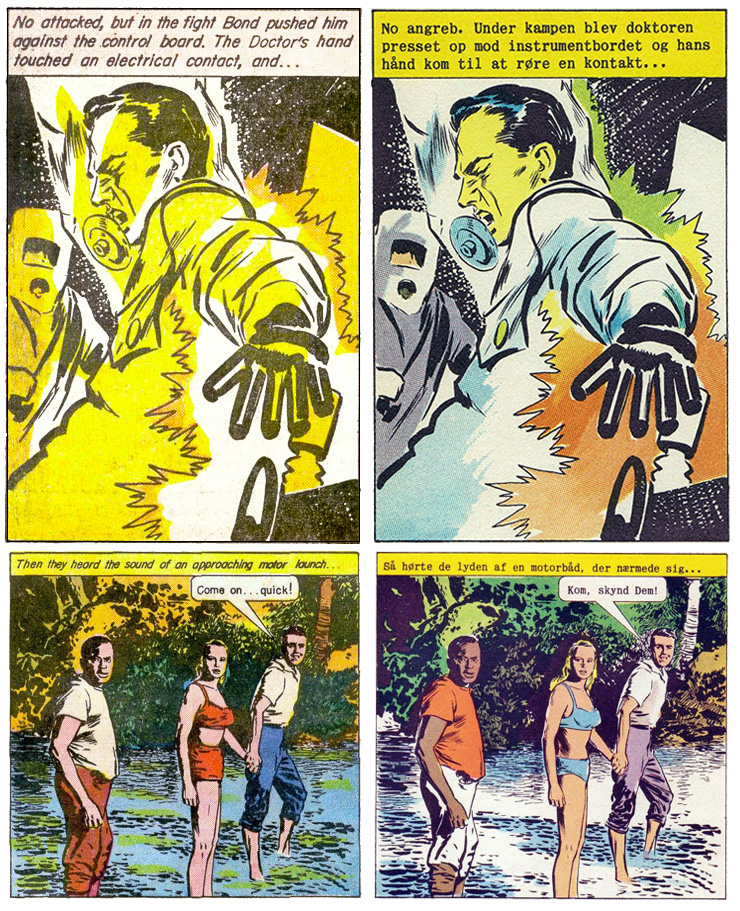|
|
| |
| |
SEEING DOUBLE! Doctor No comic book comparisons
US SHOWCASE Issue #43 March-April 1963 |
|
|
The SHOWCASE version of
Norman Nodel's Doctor No comic book was released a few months
before the first James Bond film hit cinema screens in the USA. Although
the film was a hit, the comic book adaptation did not prove to be a big
seller (it was not even marketed in the Dr. No US Pressbook), and
it would be another two decades before a James Bond film was adapted into
a comic book. The Marvel adaptation of For You Eyes Only
(1981) was illustrated by Howard Chaykin, and more in the style of
traditional comic books. The Doctor No adaptation does not resemble
the now familiar comic book style, with no dynamic sound effects or
hand-drawn dialogue, and nothing breaking free from its frame. The typeset speech bubbles and linear layout resemble
one of the crudely colourized versions of the
Daily Express
James Bond comic
strip that would later become a way to market the black & white
newspaper style to a different audience. |
|
|
|
ABOVE: (top) The
opening scene of the film in the Queen's Club served as the
reference for the first panel of the Doctor No comic book,
with the artist Norman Nodel capturing the actors’ likeness
rather loosely. (centre) Note how the three blind beggars are
now seemingly Caucasian rather than the Chinese Negroes of the UK
Classics Illustrated edition, and only one of them appears to be
carrying a gun. As the comic book was aimed at a much younger
audience, the violence was toned down from the film - which itself
was unusually graphic for its time. (bottom) The death of Strangways’
secretary Mary is also toned down with the blood-stained corpse not
shown in the comic book. The artist has also combined the removal of
Mary's body with the searching of the filing cabinet into the
same panel, whereas they
were separate shots in the film version of Dr. No (1962) |
|
|
|
|
ABOVE: (top) James
Bond's arrival in Jamaica was filmed on the first day of location
shooting on Tuesday January 16, 1962 - with Marguerite LeWars (Miss
Jamaica 1961) photographing Sean Connery at Palisadoes Airport. For
the comic book version Norman Nodel used two publicity stills from
the day and slavishly copied them down to the smallest detail. The
inking of the US version also lightens the skin-tone of ‘freelance’
Annabel Chung. (centre) The fight between Mr. Jones (Reggie Carter)
and James Bond (Sean Connery) was also illustrated using publicity
stills as the starting point. (bottom) The death of Mr. Jones was
also faithfully reproduced for the comic book, even down to the
facial expressions. |
|
|
|
|
ABOVE: (top) Bond's
meeting with Quarrel was another instance where the US SHOWCASE
version was revised due to the differing attitude toward race in
early Sixties’ America. The black Jamaican fisherman Quarrel was
re-inked to resemble a Latino type, and in some frames was
completely re-drawn so the character no longer resembled the black
American actor John Kitzmiller. (centre) Another instance of Norman
Nodel using a publicity still as a reference image, but note how the
position of Bond and Leiter has been reversed - even the wine bottle
and candle have swapped places! (bottom) Bond's meeting with
Professor Dent is also replicated from a film still, although with
some unusual colour choices in the inking. |
|
|
|
|
ABOVE: (top) Even
the simple panel of Professor Dent boarding a boat for Doctor No's
island has been referenced directly from the film. (centre) Once
again, toned down for a younger market, Professor Dent is not killed
by Bond but wounded - although the panel is a direct replica of the
controversial scene from the film. The previous panel showed Bond
and Dent shooting their guns simultaneously, so bond doesn't kill
him in cold blood. (bottom) Norman Nodel's depiction of Ursula
Andress as Honey Ryder bears no resemblance to the Swiss actress,
although the scene of her with Quarrel and Bond as they escape
Doctor No's guards, shows her wearing a rather larger bikini than
the one in the film. This was common practice with all US
advertising materials for Dr. No (1962), with all art stills
and posters retouched to cover her navel. |
|
|
|
|
ABOVE: Three more
examples of Norman Nodel's slavish replication of publicity stills.
(top right) The image of Bond, Honey and Quarrel on the Crab Key
beach was from a black & white still that was later hand-coloured
and used in the UK Front of House set. Both the FOH still and final
comic book took great liberties with the choice of colour for
Honey's bikini! Even one of the lesser-seen production stills (bottom
right) was adapted for the comic, with Honey now visible
and awake beside Bond, rather than collapsed as she the was in the
film. The comic book version makes no mention of the fact the
characters were drugged. |
|
|
|
|
ABOVE: (top) Bond's
dinner with Doctor No has again been copied from the reference still
of Joseph Wiseman and Sean Connery on Ken Adam's set at Pinewood
Studios. (centre) The panel where Doctor No's guards restrain Bond
and Honey has also been replicated from another still, which itself
became one of the images used in the UK Front of House set (centre)
right. (bottom) An instance where a publicity still has been used
but in a different context: A still of Bond (Sean Connery) fighting
with Doctor No (Joseph Wiseman) has been appropriated as the image
of him overcoming Chang. Although the page goes on to show Bond
replacing Chang on the gantry, the death of Doctor No is different
to the film version. Instead of falling into the nuclear reactor he
is electrocuted when his hand touches a contact on the control board
(see below). |
|
|
Censorship, controversy and colour |
|
 |
|
ABOVE: The
depiction of ‘freelance’ photographer Annabel Chung was inked
differently in the American version of the comic book (right) to
lighten her skin tone and change the perceived ethnicity of the
character. The original UK version (left) portrayed her more or less
as seen in the film and reference still used by Norman Nodel
when he illustrated the sequence. |
|
 |
|
ABOVE: In addition
to changing the ethnicity of all non-Caucasian characters in the US
SHOWCASE version of the Doctor No comic book, Miss Taro's
appearance was also changed, and Bond's seduction of her reduced to
a few lines with the pair now fully clothed! Artist Norman Nodel
clearly
used stills of Sean Connery and Zena Marshall as a reference.
Controversially, Kenyan-born Zena Marshall also wore eye make-up
appliances in Dr. No (as did American actor Joseph Wiseman as
Doctor No) to make her look more Asian. For the frame (above bottom
left) from
PAGE 18 of
the Doctor No comic, the artist used the still of Connery and Marshall
later used as one the US lobby card set (above top left) as a reference, but the finished
artwork was flipped horizontally left to right! |
|
|
 |


